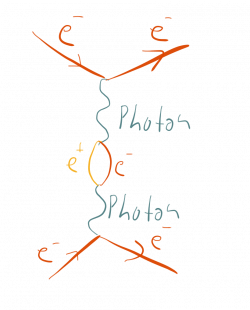Add a new page:

Feynman diagrams are a pictorial way to keep track of terms in quantum field theory calculations. Each element of a Feynman diagram represents a different term in our calculation.
The thing is that we can't calculate things in quantum field theory exactly, but only using a perturbation approach (Taylor series). The first term in this approximation to the correct result yields the biggest contribution and thus is the most important part.

An example can be seen on the right-hand side. In this example two electrons scatter. They do this by exchanging a photon $\gamma$, which is denoted by a wiggly line. After the exchange of the photon the two electrons move away from each other with different momenta.
In the first order approximation (i.e. when we only consider the first term in the approximation series mentioned above) the two electrons scatter by only exchanging a photon.
However, at the next order we also take into account that the photon can become a virtual electron-positron pair during this exchange. This will not happen with a high probability but is possible. Even more unlikely, but also possible, is that the virtual electron interacts with one of our in-going electrons via another photon. The total probability amplitude for the scattering to happen is the sum over all such possibilities.
Take note that the usage of Feynman diagrams is not limited to Quantum Mechanics. See:
Feynman Rules Resources:
It struck Feynman that everyone had a favorite principle or theorem and he was violating them all… Feynman knew he had failed. At the time, he was in anguish. Later he said simply: “I had too much stuff. My machines came from too far away.”[…] Schwinger’s students at Harvard were put at a competitive disadvantage, or so it seemed to their fellows elsewhere, who suspected them of surreptitiously using the diagrams anyway. This was sometimes true… Murray Gell-Mann later spent a semester staying in Schwinger’s house and loved to say afterward that he had searched everywhere for the Feynman diagrams. He had not found any, but one room had been locked…from "Genius" by Gleick